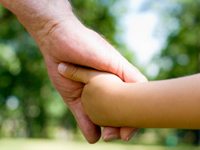First Children’s Mental Health Report

On May 16, 2013 a CDC report was released that describes, for the first time, federal activities that track U.S. children’s mental disorders. Find out about children’s mental health and what we have learned.
The term childhood mental disorder means all mental disorders that can be diagnosed and begin in childhood (for example, attention-deficit/hyperactivity disorder (ADHD), Tourette syndrome, behavior disorders, mood and anxiety disorders, autism spectrum disorders, substance use disorders, etc.). Mental disorders among children are described as serious changes in the ways children typically learn, behave, or handle their emotions. Symptoms usually start in early childhood, although some of the disorders may develop throughout the teenage years. The diagnosis is often made in the school years and sometimes earlier. However, some children with a mental disorder may not be recognized or diagnosed as having one.
Childhood mental disorders can be treated and managed. There are many evidence-based treatment options, so parents and doctors should work closely with everyone involved in the child’s treatment — teachers, coaches, therapists, and other family members. Taking advantage of all the resources available will help parents, health professionals and educators guide the child towards success. Early diagnosis and appropriate services for children and their families can make a difference in the lives of children with mental disorders.
An Important Public Health Issue
Mental health is important to overall health. Mental disorders are chronic health conditions that can continue through the lifespan. Without early diagnosis and treatment, children with mental disorders can have problems at home, in school, and in forming friendships. This can also interfere with their healthy development, and these problems can continue into adulthood.
Children’s mental disorders affect many children and families. Boys and girls of all ages, ethnic/racial backgrounds, and regions of the United States experience mental disorders. Based on the National Research Council and Institute of Medicine report (Preventing mental, emotional, and behavioral disorders among young people: progress and possibilities, 2009) that gathered findings from previous studies, it is estimated that 13 –20 percent of children living in the United States (up to 1 out of 5 children) experience a mental disorder in a given year and an estimated $247 billion is spent each year on childhood mental disorders. Because of the impact on children, families, and communities, children’s mental disorders are an important public health issue in the United States.

Monitoring Children’s Mental Health
Public health surveillance – which is the collection and monitoring of information about health among the public over time – is a first step to better understand childhood mental disorders and promote children’s mental health. Ongoing and systematic monitoring of mental health and mental disorders will help
- increase understanding of the mental health needs of children;
- inform research on factors that increase risk and promote prevention;
- find out which programs are effective at preventing mental disorders and promoting children’s mental health; and
- monitor if treatment and prevention efforts are effective.
CDC issues first comprehensive report on children’s mental health in the United States
A report from the Centers for Disease Control and Prevention (CDC), Mental Health Surveillance Among Children —United States, 2005–2011, describes federal efforts on monitoring mental disorders, and presents estimates of the number of children with specific mental disorders. The report was developed in collaboration with key federal partners, the Substance Abuse and Mental Health Services Administration (SAMHSA), National Institute of Mental Health (NIMH), and Health Resources and Services Administration (HRSA). It is an important step towards better understanding these disorders and the impact they have on children.
This is the first report to describe the number of U.S. children aged 3–17 years who have specific mental disorders, compiling information from different data sources covering the period 2005–2011. It provides information on childhood mental disorders where there is recent or ongoing monitoring. These include ADHD, disruptive behavioral disorders such as oppositional defiant disorder and conduct disorder, autism spectrum disorders, mood and anxiety disorders including depression, substance use disorders, and Tourette syndrome. The report also includes information on a few indicators of mental health, specifically, mentally unhealthy days and suicide.
Who is Affected?
The following are key findings from this report about mental disorders among children aged 3–17 years:
- Millions of American children live with depression, anxiety, ADHD, autism spectrum disorders, Tourette syndrome or a host of other mental health issues.
- ADHD was the most prevalent current diagnosis among children aged 3–17 years.
- The number of children with a mental disorder increased with age, with the exception of autism spectrum disorders, which was highest among 6 to 11 year old children.
- Boys were more likely than girls to have ADHD, behavioral or conduct problems, autism spectrum disorders, anxiety, Tourette syndrome, and cigarette dependence.
- Adolescent boys aged 12–17 years were more likely than girls to die by suicide.
- Adolescent girls were more likely than boys to have depression or an alcohol use disorder.
Data collected from a variety of data sources between the years 2005-2011 show:
Children aged 3-17 years currently had:
- ADHD (6.8%)
- Behavioral or conduct problems (3.5%)
- Anxiety (3.0%)
- Depression (2.1%)
- Autism spectrum disorders (1.1%)
- Tourette syndrome (0.2%) (among children aged 6–17 years)
Adolescents aged 12–17 years had:
- Illicit drug use disorder in the past year (4.7%)
- Alcohol use disorder in the past year (4.2%)
- Cigarette dependence in the past month (2.8%)
The estimates for current diagnosis were lower than estimates for “ever” diagnosis, meaning whether a child had ever received a diagnosis in his or her lifetime. Suicide, which can result from the interaction of mental disorders and other factors, was the second leading cause of death among adolescents aged 12–17 years in 2010.
Looking to the Future
Public health includes mental health. CDC worked with several agencies to summarize and report this information. The goal is now to build on the strengths of these partnering agencies to develop better ways to document how many children have mental disorders, better understand the impacts of mental disorders, inform needs for treatment and intervention strategies, and promote the mental health of children. This report is an important step on the road to recognizing the impact of childhood mental disorders and developing a public health approach to address children’s mental health.
What You Can Do
Parents: You know your child best. Talk to your child’s health care professional if you have concerns about the way your child behaves at home, in school, or with friends.
Youth: It is just as important to take care of your mental health as it is your physical health. If you are angry, worried or sad, don’t be afraid to talk about your feelings and reach out to a trusted friend or adult.
Health care professionals: Early diagnosis and appropriate treatment based on updated guidelines is very important. There are resources available to help diagnose and treat children’s mental disorders.
Teachers/School Administrators: Early identification is important, so that children can get the help they need. Work with families and health care professionals if you have concerns about the mental health of a child in your school.
References
- National Research Council and Institute of Medicine. Preventing mental, emotional, and behavioral disorders among young people: progress and possibilities. Washington, DC: The National Academic Press; 2009.
- Centers for Disease Control and Prevention. Mental health surveillance among children – United States, 2005—2011. MMWR 2013;62(Suppl; May 16, 2013):1-35.